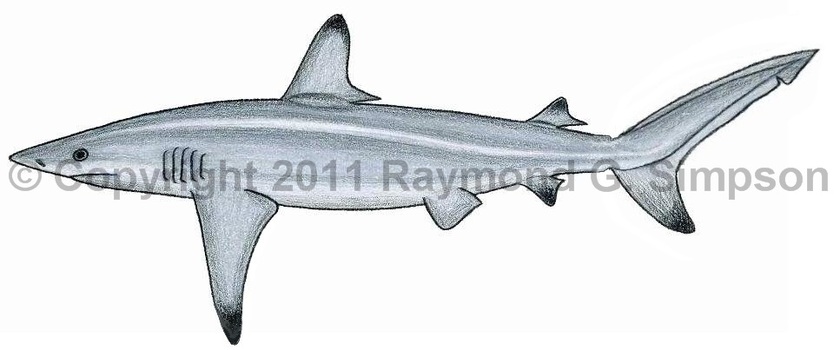
Common Name
Spinner Shark
Year Described
Müller and Henle, 1839
Identification
Anteroposterior tooth rows: 15-18/14-17 on each side; 32-37/29-35 total
Vertebrae: 84-96 precaudal, 155-185 total
A large and slender shark with a moderately large and pointed snout. Eye small. Distance between nostrils 1.5-1.8 times in pre-oral distance. Nasal flaps rudimentary or very short. Upper labial furrows short but stronger than in other species in the genus. Interdorsal ridge is absent. Long preanal ridge absent. No keels on caudal peduncle. Gill slits rather long (3.6-5.5% TL). Teeth in upper jaws broad-based with very narrow, erect cusps, and finely serrated edges. Lower jaw teeth thick-based and smooth, with slender, erect cusps. First dorsal fin fairly high (6.0-8.8% TL) with a convex anterior margin, a rounded tip, and inserted over or behind free tip of pectoral fin. Second dorsal fin much smaller (1.8-2.5% TL) and inserted directly above anal fin. Both dorsal fins with extended free posterior tips (second dorsal free tip shorter than twice height of second dorsal). Anal fin similar in size to second dorsal fin. Pelvic fin origin well behind free tip of first dorsal. Pectoral fin moderate, slightly falcate, with a pointed tip.
Color
Dark gray above, abruptly whitish below. The white often extends onto side as a white stripe. Fins body color. Second dorsal, anal, pectoral, and lower caudal fins with dark tips (except juveniles).
Size
Mature adults from 159-203cm TL. Newborns from 60-75cm. Maximum size to 280cm TL.
Habitat
Inshore to offshore pelagic over continental shelves from 0-100m. Often forms small schools.
Range
North Carolina to the Gulf of Mexico and the northern Caribbean Sea. Spotty records through the rest of the S. Caribbean. Also northern S. America to southeastern Brazil.
References
Castro, J.I. 2011. The Sharks of North America. Oxford University Press, 640 pp.
Compagno, L.J.V. 2002. Sharks. In: Carpenter, K.E. (Editor) FAO Identification Guide for Fishery Purposes. The Living Marine Resources of The Western Central Atlantic. Volume 1: Introduction, mollusks, crustaceans, hagfishes, sharks, batoid fishes, and chimaeras. ASIH Special Publication No. 5. FAO, Rome.
Compagno, L., M. Dando, and S. Fowler. 2005. Sharks of the World. Princeton University Press, 480 pp.